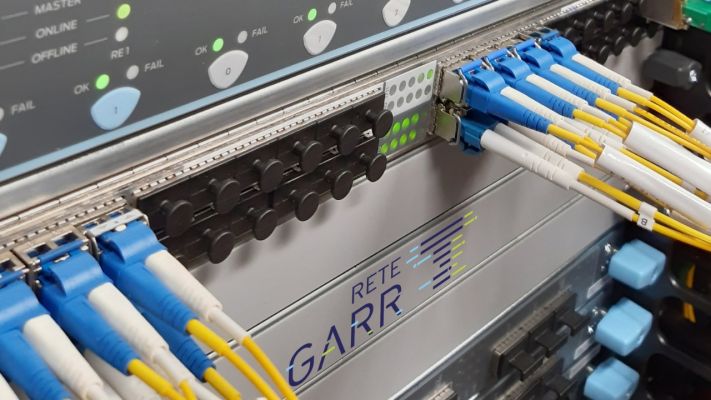Introducing GARR-T: the new ultra-fast network for universities and research
The creation of the new, powerful, widespread and flexible network is complete. Now, throughout Italy, the optical fiber backbone exceeds a capacity of 20 Terabits per second.
Today, the new GARR-T network dedicated to the world of research, education and culture is fully operational. This network, spanning a 20,000 km path of optical fiber distributed extensively across the country, marks a significant leap forward in high-performance connectivity. Professors, students, and researchers from every discipline can rely on a fast and reliable infrastructure to exchange real-time data, securely access resources, perform high-power calculations, and manage large amounts of data. Moreover, with interconnection to global networks, GARR-T facilitates international collaboration between research institutions and universities.
The name GARR-T, like Terabit, represents a notable progression in the scale of connections currently accessible. The backbone has, in reality, expanded remarkably, boosting its capacity from 3 to over 20 Terabits per second.
The project started in September 2021 with the initial installations on the transmission network. In record time, it expanded across the entire country, relying on effective teamwork between GARR and the staff of research institutions and universities hosting the approximately 80 network nodes involved.
Claudia Battista, Director of GARR, expresses great satisfaction with this achievement: "I am very proud of the milestone we have reached one month ahead of schedule. From today, Italy has an important resource to tackle the new challenges of research and positions itself technologically at the forefront in Europe and the world." But this is just the first step. The GARR team continues to work on further enhancing and expanding the network to other areas of the national territory. While this initial phase of GARR-T was realized through a €25 million investment from GARR funds, the upcoming expansion relies on resources from the National Recovery and Resilience Plan (NRRP) with the TeRABIT projects (which will see the extension and enhancement of the optical fiber backbone to Sardinia and southern Sicily) and ICSC Foundation (dedicated to strengthening the backbone and access for sites involved in the National Center for Research in HPC, Big Data, and Quantum Computing).
"With GARR-T, we have achieved technological standards of excellence that allow us to interconnect research centers, laboratories, and university campuses anywhere in the world," comments Massimo Carboni, Chief Technical Officer of GARR. "The minimum capacity of the backbone connections is 100 Gigabits per second, and we have already provided cutting-edge services, such as the recent connection between two data centers (INFN-CNAF in Bologna and CERN in Geneva), with speeds of 1.6 Tbps thanks to the sharing of multi-domain optical spectrum."
The packet and optical networks in GARR-T have undergone a complete revolution, now offering new functionalities to the national research and university community.
Among the benefits, there is the possibility of monitoring performance more efficiently, thanks to the introduction of telemetry and automation, enabling the management of a greater volume of information and interaction with devices through software tools. Telemetry also reduces the time for certain operations, such as testing new circuits, which now takes only 5 minutes instead of 40.
Regarding the optical network, 750 km of new optical fiber routes have been deployed, with a total of 6,200 kilometers involved in the evolution of the GARR-T backbone. With these numbers, the new network can make a significant contribution to reducing the digital divide in Italy. One of its distinctive features is its greater coverage, bringing advanced functionalities not only to central nodes but also to peripheral sites, ensuring fair and advanced access to connectivity and resources.
Among the available innovative services, spectrum sharing allows expanding the network's capabilities, overcoming economic or geographic obstacles, such as in the case of
submarine cables or remote locations that are difficult to reach with optical fiber.



 Telegram
Telegram